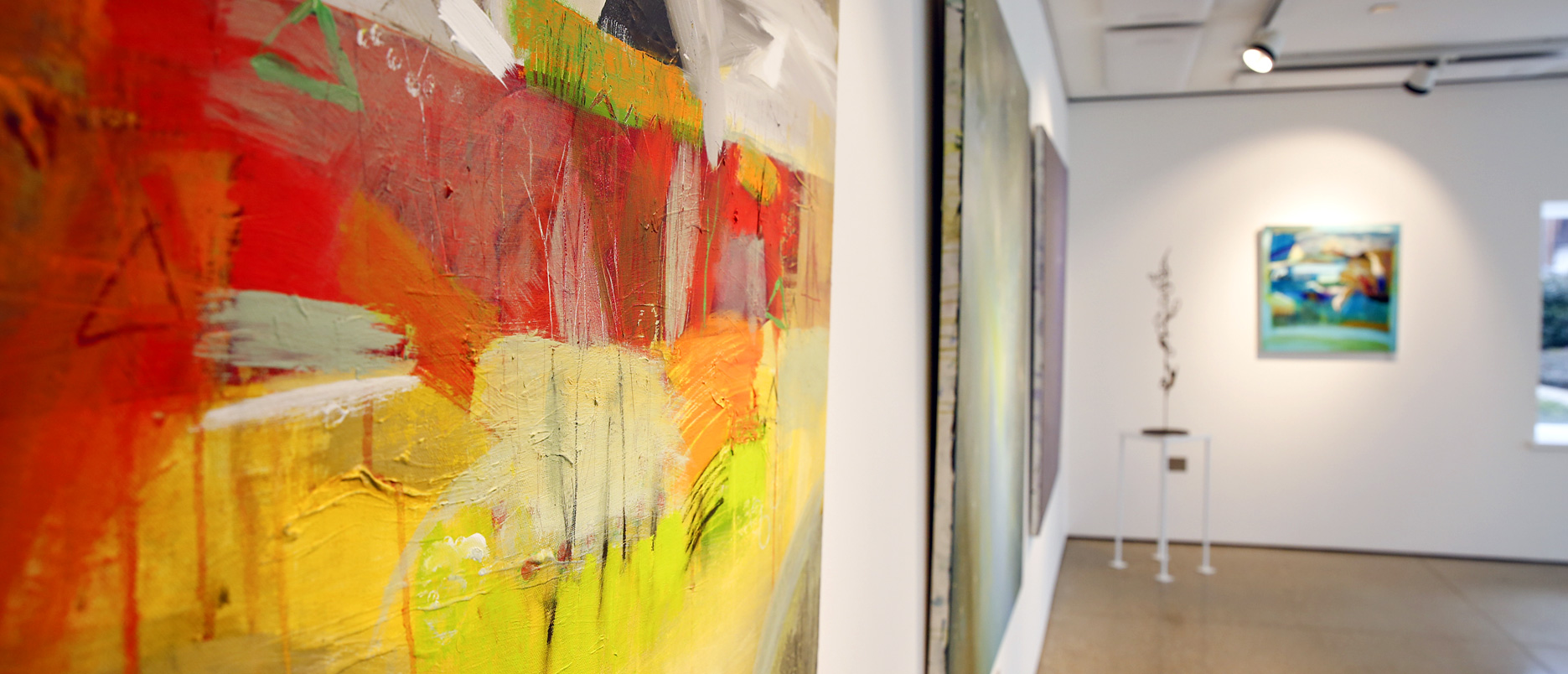
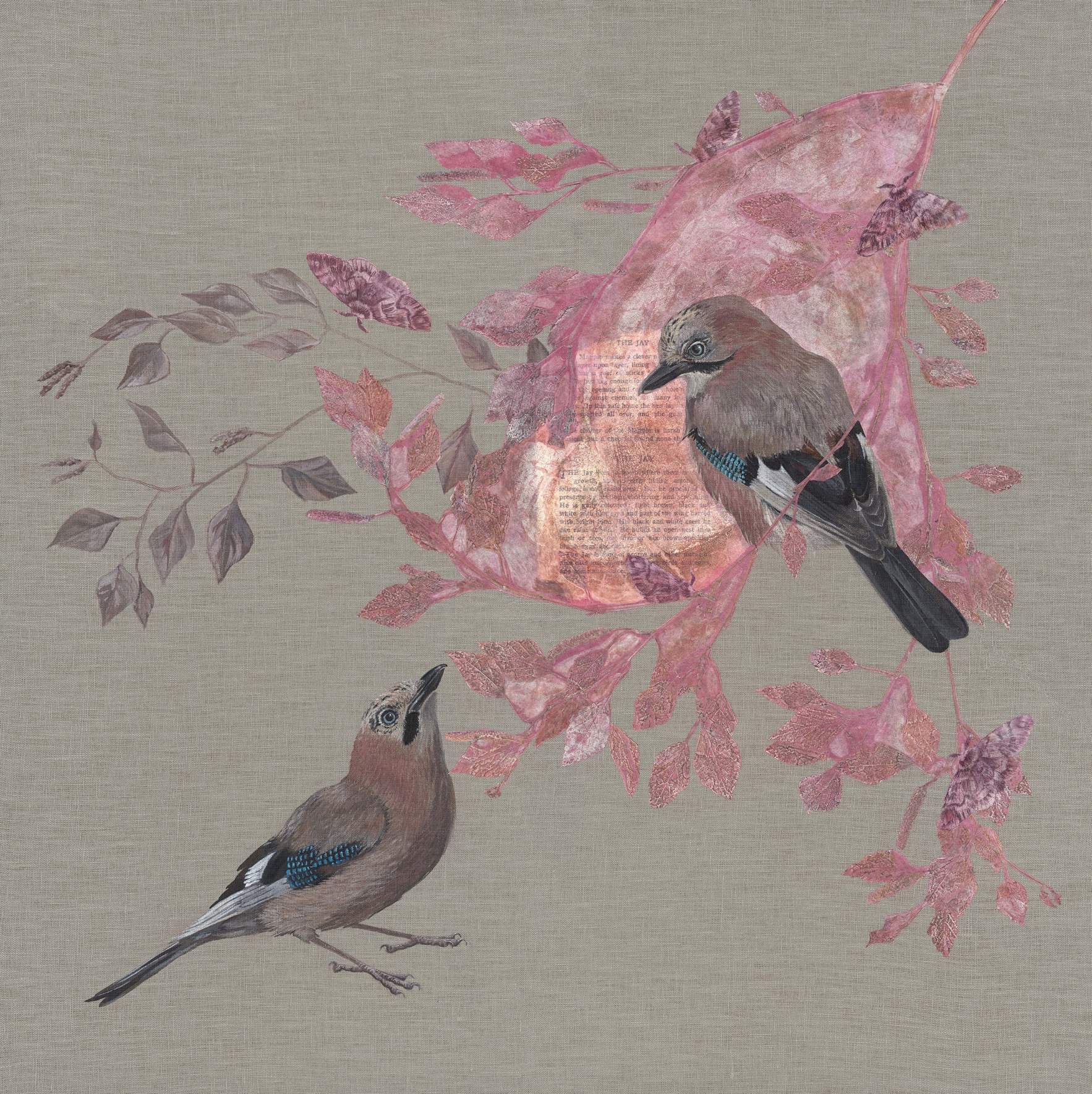
Woodchurch based artist Jade Taylor works across a range of disciplines from her purpose-built studio surrounded by the nature that inspires her. Jade’s work is a response to the beauty and fragility of the natural world and in particular our native wildlife and habitats and ecosystems. Her delicate collaged works combine acrylic on linen with layers of botanical printmaking and etchings.
Trained as a textile designer at Nottingham Trent University, Jade specialised in embroidery during her degree and her love of colour and pattern flows through her current body of work.
Printmaking has been at the centre of Jade’s practice for many years. Combining printmaking with painting to create representational and sometime whimsical works on linen and paper, with connections in the natural world and the environment very much at their heart.
Jade’s work is held in private collections in the UK, Europe, New Zealand and Japan. Having taught Fine Art for nearly 30 years, she is now focusing on her own practice once again, but also delivers workshops, courses and private tuition from her garden studio.
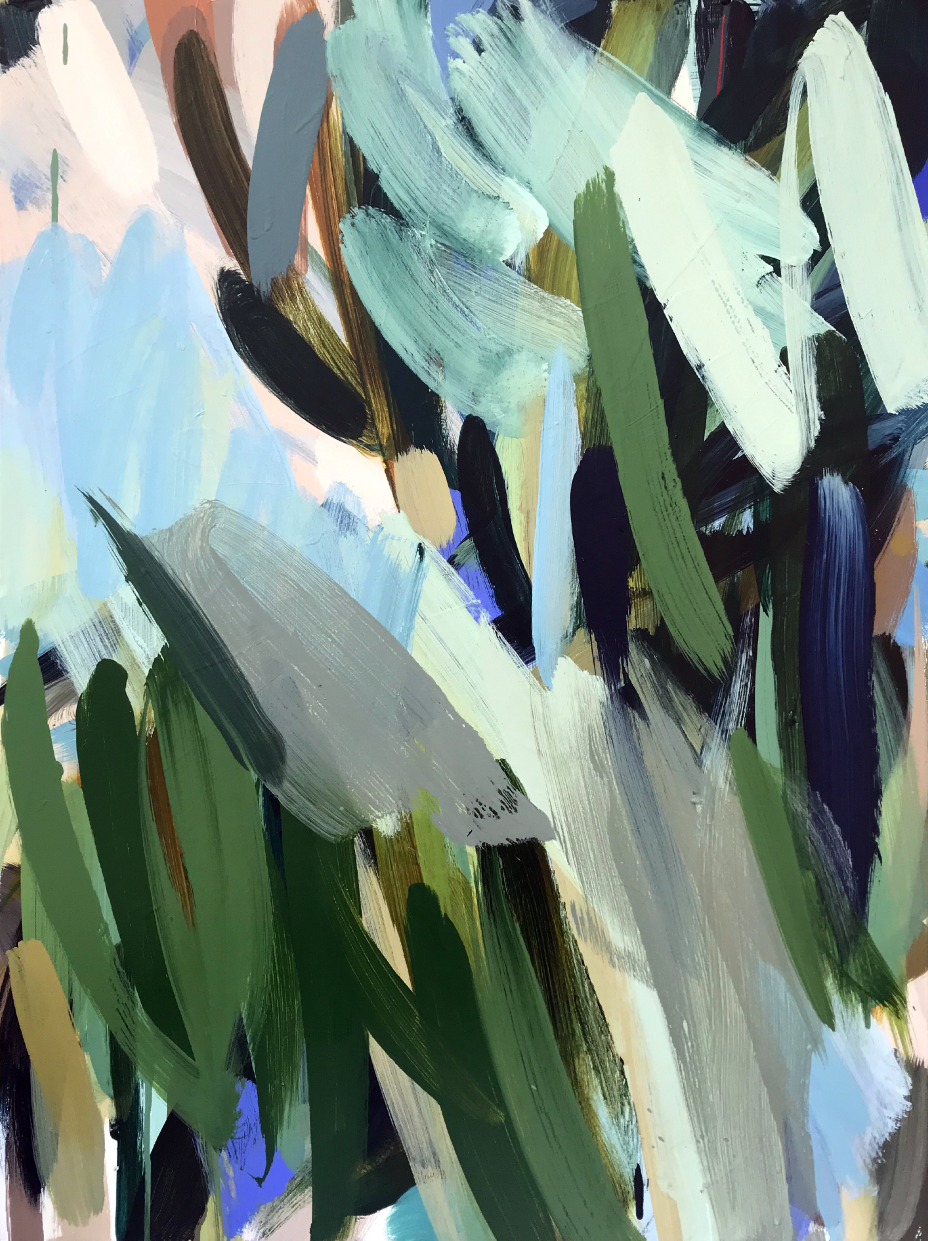
My paintings evolve from a process of observing shapes, forms and colours in nature, around where I live near the South Downs, and also further a field. The paintings are characterised by distinct colour palettes and gestural marks, that I hope capture the movement and atmosphere of the landscape. Layered and woven colour and interlocking shapes provide depth and rhythm. Dark blues, greens and grey hues contrast with tints of red, orange and yellow; darkness contrasts with light, shade with luminosity. Colours and marks reveal themselves and new forms emerge, layer over layer, linking back to a memory of a time and place.
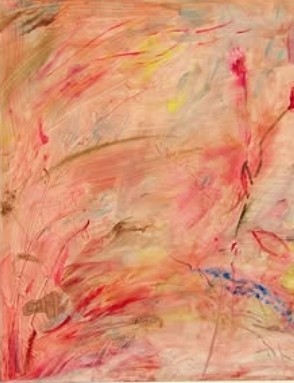
Lulu Weide The untameable nature of paint drives my practice, more than a thirst for control over it. Using a combination of Oil paint, pastels, and sticks, my work revels in the abstraction of fleeting moments, taking inspiration from colours, shapes, and patterns that form unprocessed in the natural environment around us. By immersing oneself in every line and stroke, the attention that each fragment of the painting holds over the viewer becomes more significant than the whole image itself. Intuition is a crucial part of my practice, endeavouring to replicate just some of the abundance of patterns in nature, both in the physical language of line and shape and in repetitive cycles in history. My willingness to work with and not against the spaces we encounter echoes throughout.
Instagram: @luluweidestudio
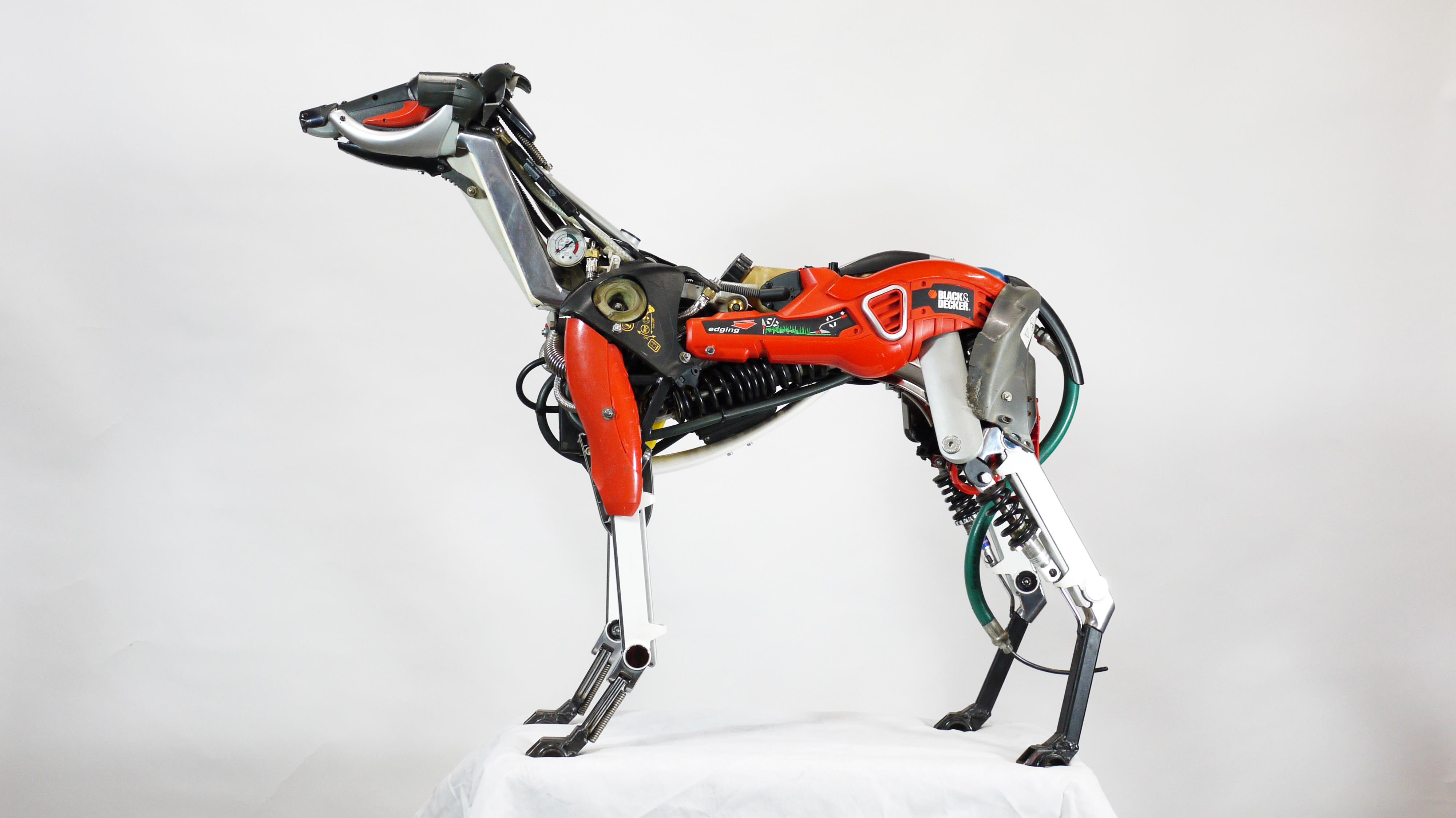
Hubcap Creatures is actually Ptolemy Elrington.
Ptolemy was born in the south of England but grew up in the north. He studied art and design to degree level at Bradford and Illkley Community College in the mid eighties. He has travelled extensively and has worked at a variety of jobs. These have included theatre set design and construction, stage design and construction, assorted large scale community art sculptural projects and all whilst pursuing his own artistic agenda.
Within his work he concentrates on creating sculpture of natural forms from found and re-cycled materials. At the moment he is working with a variety of materials including shopping trolleys, scrap metal and car wheel trims which he re-shapes into a variety of life forms.
Past clients include DEFRA (formerly MAFF), The Eden Project, Kenwood, the R.S.P.B., The Environment Agency, WWF, Essex County Council, Brighton County Council, Ronseal, Anglian Water, East Coast Trains, Ecover, DHL and Flora.
TV appearances include Richard and Judy, Blue Peter, Smart and Art Attack and Collectors Lot.
Printed media appearances include The Times, The Telegraph, The Daily Mail, The Sun, FHM, The Observer and numerous local papers as well as many international magazines and papers.
hubcapcreatures.com
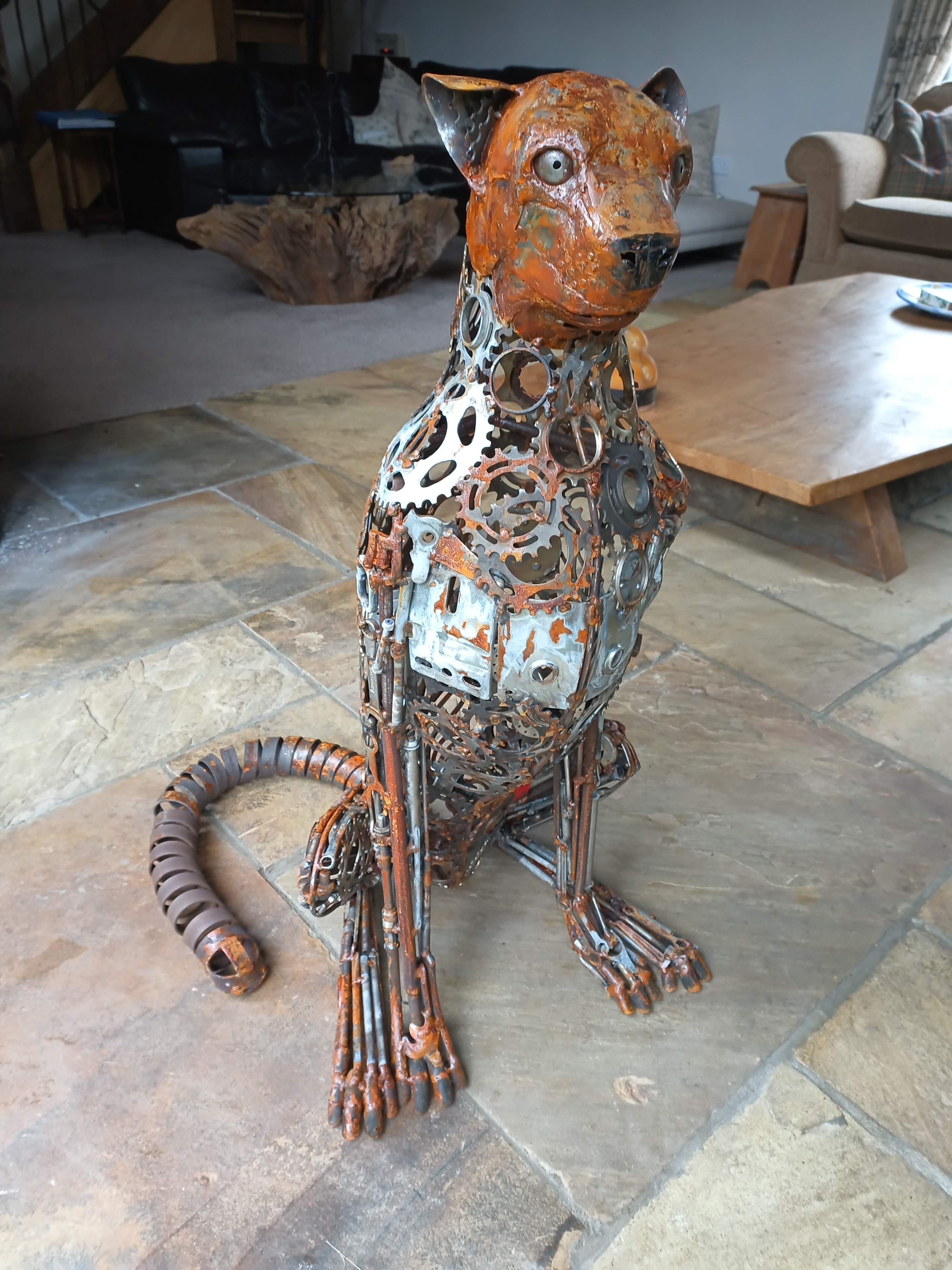
Most sculptures are fabricated entirely from sheet metal but some introduce mixed media in the form of salvaged or drift wood to enhance the representation of nature. Others are made entirely from scrap metal: reusing materials and reforming them into a beautiful piece of art which reflects nature and which, somehow, seems a fitting way of demonstrating the ongoing worth of the materials often so readily discarded.
Many of the artist’s pieces are an observation of nature, using this man-made material to capture the unique movement, character and alertness for which animals and birds are so much loved and which makes these sculptures such a popular personal art choice.
dadeymetalart.co.uk
Instagram: diccondadey
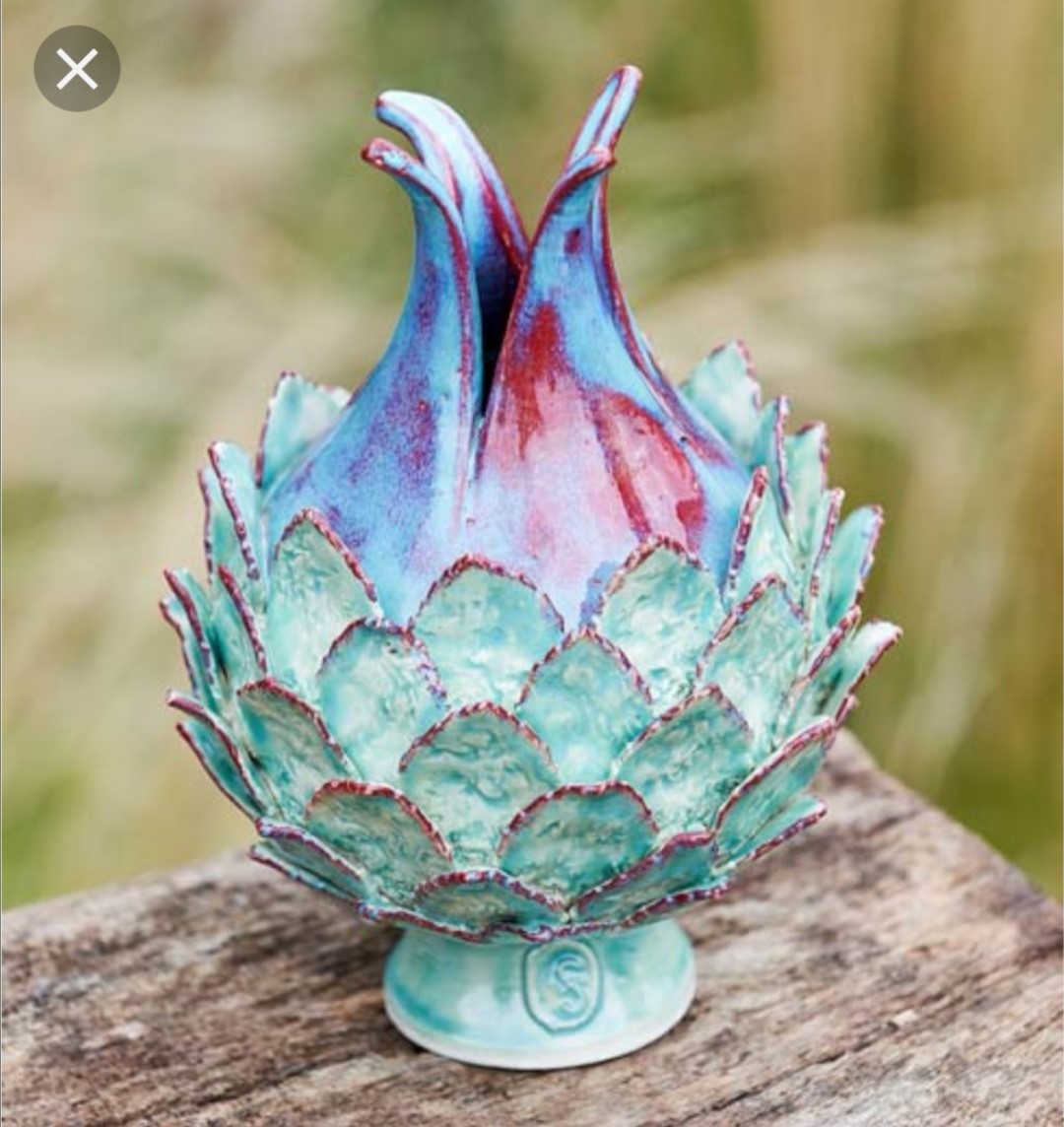
From 1986 to 1996 I owned a restaurant in Brighton and sold it when I became hooked on ceramics at an evening class. So that I could study the subject further. I spent five years at college, studying photography and plastics as well as ceramics. When I graduated in 2001, I took out a lease on workshop premises in Hove, and sublet spaces to other artists/craftspeople. Since then I have exhibited and sold my work at art fairs and galleries throughout the British Isles. In 2004 I won an award for Best Newcomer at BCTF, and have written features for their magazine “The Craftsman’. I took a post grad in teaching and learning in HE, and have worked part-time as a tutor at Northbrook College, Brighton University and HMP Ford.
My inspiration comes from flowers and plants that we see all around us, in gardens, fields even cracks in the pavement. I particularly love the secret worlds inside these flowers, in the patterns and textures hidden away that give a continuing sense of promise and renewal.
Until 2005 my work had been mainly in the domestic & functional arena, but then I decided to work on larger, often one off, sculptural pieces. So far, I have concentrated on the forms of seed pods and fruiting bodies which ties in with my earlier work, but which looks completely different.
I like to play with scale and will often imagine the size that a plant must appear to an insect…what is it about the flower that attracts or repels? Often I will scale my sculpture up so that we can have an ‘insects eye view’ of it.
I work in stoneware, throwing the basic shape of the sculpture, then I alter and model onto it. This gives me a certain speed and control which is the way I prefer to work. My pieces are high fired so that they can go into an interior or exterior environment.
My glazes are chosen to compliment the form and are often slightly chrystalline or irradescent, this makes the pieces glow.
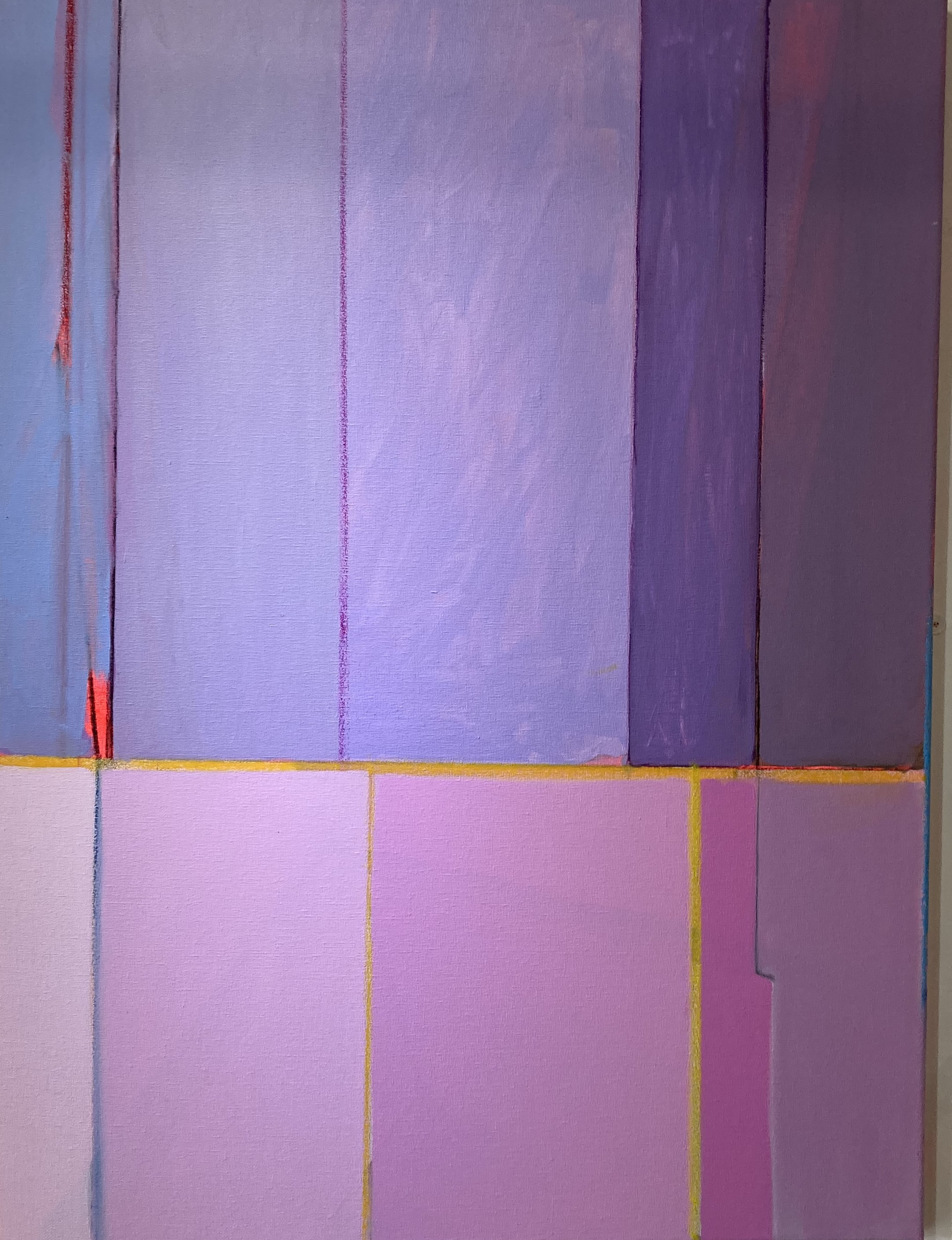
Patrick is an artist and curator based in Phoenix Art Space Studios, Brighton. He gained BA (Hons) Fine Art at Southampton Institute 1997. He is interested in the perception of space – the boundaries and opacities of colour, line and edge and the subsequent effects when they meet or merge. Working in a reductive and non figurative manner offers him the freedom to filter a variety of inspirations, ideas and experience through exploring the relationships of simple formal elements. O’Donnell oscillates between painting and printmaking as both processes are important to his practice and inform each other.
Recent exhibitions include ‘focus: united kingdom’ Nonsofia Gallery, Sofia, Bulgaria, Sea-saw – Nairn Arts Centre, Linden Hall Studios Winter Show, On Paper – International Print Exhibition, Barcelona, Sussex Open at Towner Gallery, Annual Open Royal West of England Academy, Royal Ulster Academy Open in the Ulster Museum, Aberdeen Artists Society Open – Aberdeen Art Gallery, Huddersfield Art Gallery, A Generous Space- Hastings Contemporary and the H_A_R_D_P_A_I_N_T_I_N_G series of exhibitions at Phoenix At Space Brighton including this year’s H_A_R_D_P_A_P_E_R. He has work in public and private collections in the UK, France and USA.
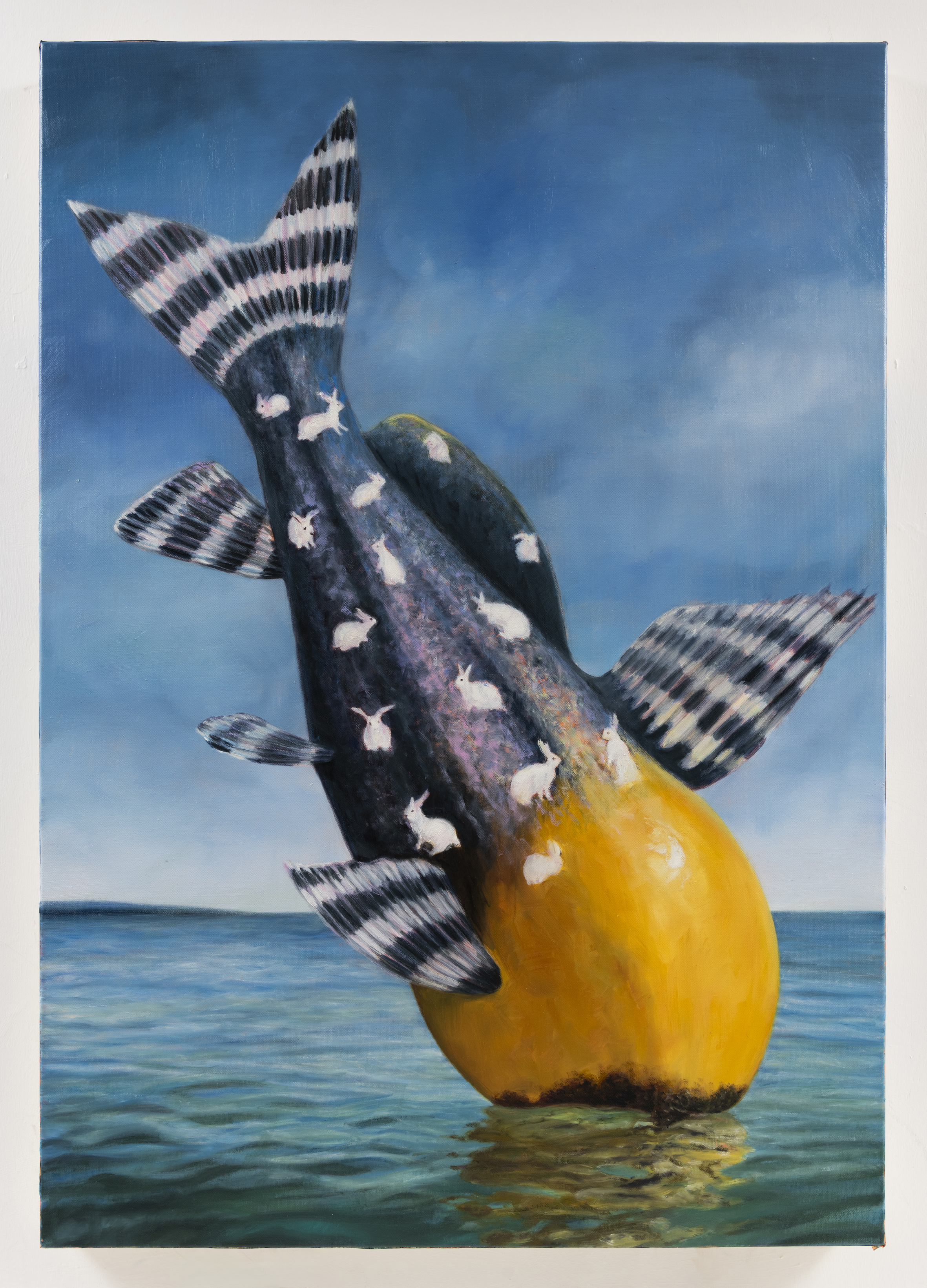
Perdita Sinclair seeks out diverse first-hand experiences to inform the constructions of reality in her work. She pulls together climate change concerns, theories around mental health, and the beauty and challenges of scientific research with her lived experiences to create her hyper-visual, shape-shifting paintings and multidisciplinary work.
Sinclair’s interest in mental health, especially Carl Roger’s theories that challenge the notion that we all inhabit the same reality has led her to train as a Person-Centred Counsellor. Her art draws parallels with this notion, and the Schrödinger’s cat thought experiment, situating it in a kind of superposition where many realities could be possible. This superposition also speaks of the unsettled Anthropocene times in which we live, where things are dramatically shifting in the world.
Much of her work is related to blue conservation and she regularly sea swims. She conducted a residency with Sail Britain and has been inspired by the work of marine scientists at the National Oceanography Centre and European Marine Board. She is currently collaborating with Sussex Bay to bring greater attention to the marine conservation zones.
Her intrepidity has also seen her collaborate with Functional Anatomy, leading to her becoming artist in residence on human dissection courses at both Oxford University and Imperial College. She has also conducted two painting residencies with ESKFF at Mana Contemporary, USA, and worked alongside scientists from Royal Botanic Gardens, Kew, to make a large light installation that spanned the length of the Millennium Seed Bank atrium. She has exhibited extensively in the UK and internationally, including recently at Mana Contemporary, USA, and the Royal Academy of Art, London.
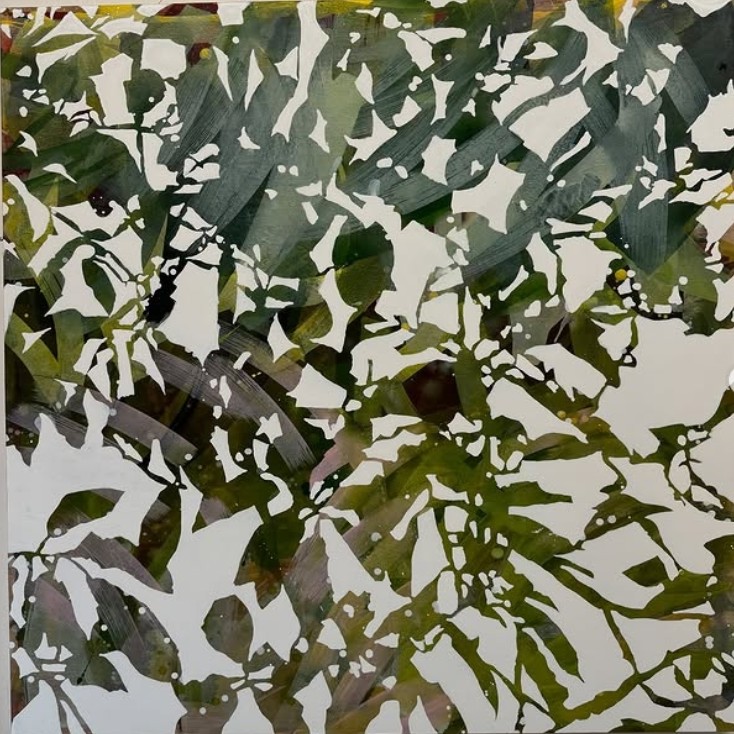
I am a Lancashire born/London based contemporary painter. My consistent focus for several years has been to experiment with the breadth of the spectrum between representation and abstraction. I explore the concept of examining organic and abstract forms, defined by negative space. Taking something that is not there, the space between things, and making that the subject of the paintings.
My work invites the viewer to look closely at what are essentially abstract shapes and marks, but I like to explore the way the brain visually tries to make sense of what it is seeing, to find recognisable information. In that way, abstract shapes that, close-up, appear to float above the painted background, then reform and recede as one steps back, they become ‘the background’. The brain rejigs what we are seeing and the white areas of negative space becomes recognisable as ‘light through leaves’.
In this way each series of work starts with a subject but progresses towards abstraction as I explore the subject and render it in two dimensions, examining line and shape, negative space and the effects of light, and as a result the link to the subject slowly becomes stretched and obscured to varying degrees.
I also enjoy examining opposites within my work; the contrast of loose, expressive brushstrokes overlaid with drawn lines and painstaking fine brush work; the play between positive and negative space, between foreground and background; the interplay of abstraction with the suggestion of representing something recognisable.
www.rebeccatucker.co.uk
